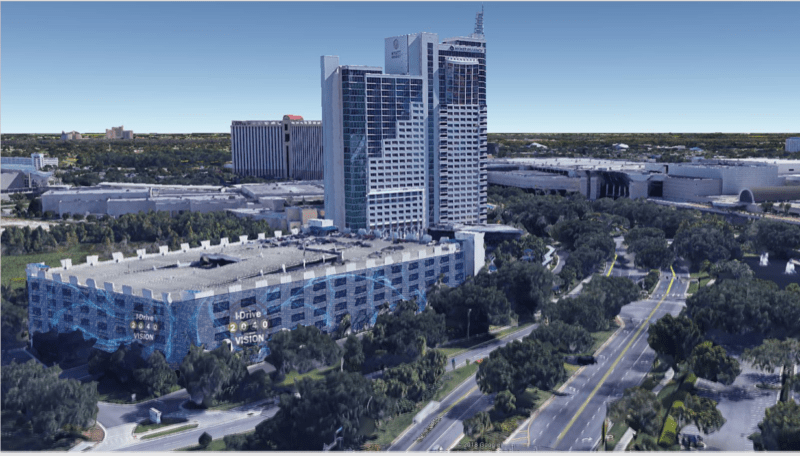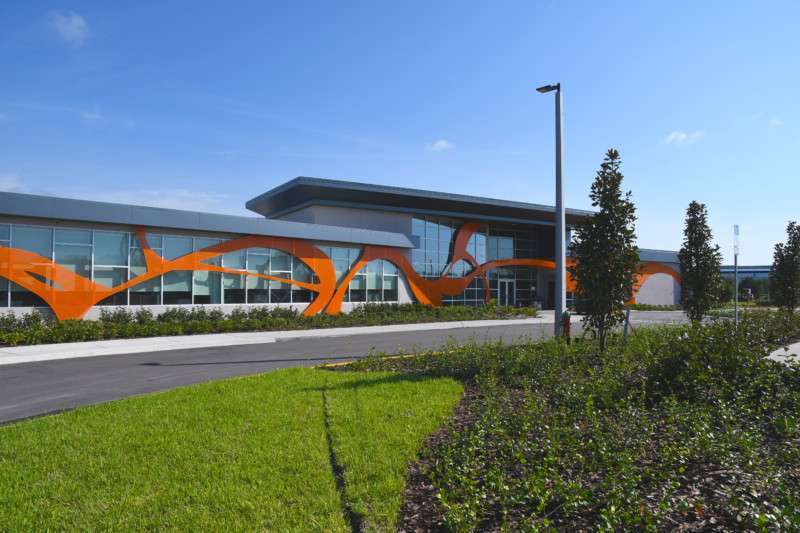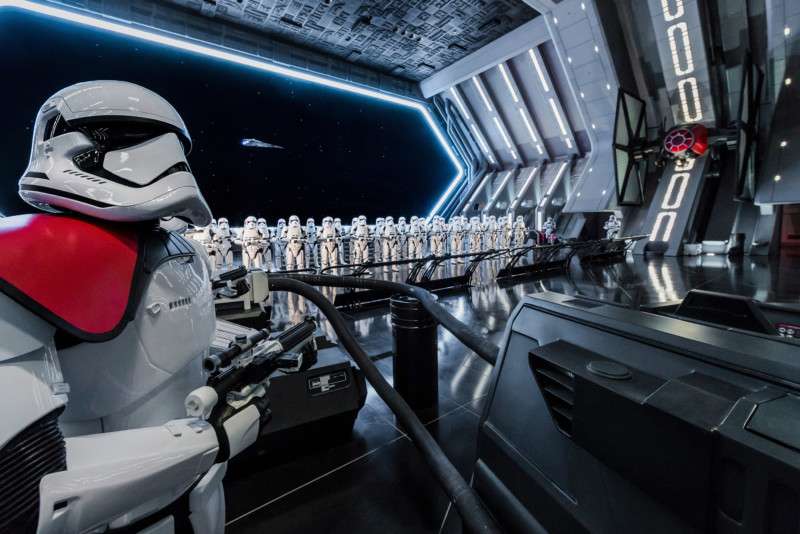The theme park capital is becoming a better place to live, work and vacation
by Rona Gindin
ABOVE: Disney’s Rise of the Resistance attraction, slated for a December 2019 opening in Orlando, is expected to bring the latest technologies into a dark ride experience. Photo ©Disney.
Metro Orlando (Florida) is a dynamic destination in the process of becoming. It is sprouting in every direction – cultural venues, job sectors, schools, college campuses, and hospitals. Much of the expansion is related to the attractions industry, which continues to lead in tourism and employment.
Entire neighborhoods spring out of green fields. Massive attractions bubble up from bare land. Shiny new tech hubs bring gizmos and gadgets to futuristic levels. All this growth provides opportunities but also challenges – among them infrastructure, transportation and affordable housing.
About those theme parks
The Theme Park Capital of the World has a wealth of always evolving Disney, Universal, SeaWorld and LEGOLAND theme parks, plus an ever-growing inventory of smaller attractions. Tourism supports about one-third of the local economy, according to the Orlando Economic Partnership.
All eyes are on Universal’s Epic Universe, a 750-acre property that Universal plans to open in five years with one or two theme parks plus entertainment, dining and lodging. Meanwhile, Disney World continues to enhance its Star Wars: Galaxy’s Edge land themed around the Star Wars franchise at Disney’s Hollywood Studios, and is undertaking to practically rebuild half of Epcot.
Smaller attractions thrive as well, since 75 million people visit the Central Florida market every year. “This broadens the range of regional offerings for guests, particularly to those staying for an extended period and those who may not have as much discretionary income, thereby complimenting the area’s more iconic destinations,” said Brian Sands, AICP, Vice President / Principal – Economics, AECOM. Sands sits on the International Board of the Themed Entertainment Association (TEA) and leads the research team of the TEA/AECOM Theme Index, an oft-cited, annual attendance study of the world’s top theme parks.
The attractions range from a modest axe-throwing venue to splashy go-kart-facilities, from one-off thrill rides like the StarFlyer swing ride to indoor kid-magnets like the Crayola Experience at a regional mall. Wild Florida, originally a simple spot for airboat rides and alligator sightings, is adding a drive-through wildlife park and a zipline. Then there’s the development of I-Drive (see below).
“Orlando has matured so that there’s room for smaller operators to make a go of it here,” observed Brian Morrow, who before founding his Orlando-based attractions design firm BMorrow Productions in 2018 was VP Theme Park Experience Design, SeaWorld Parks and Entertainment. “Look at Fun Spot [twin amusement parks], which have big rides now and have really carved out a specialty niche, and the Margaritaville resort in Kissimmee, which was able to use new technologies at its H2O Live! waterpark to offer line reservations and custom music on slides.”
Sports play a part, too. ESPN Wide World of Sports at Disney World brings in huge numbers of competitors over the year, but it’s not alone. The state-of-the-art 100-court USTA National Campus in Lake Nona is a magnet for tennis players. Lake County, called the Choice of Champions because Olympic competitors train there, also has Jetsurf Academy Orlando, Hickory Point Beach Sand Volleyball, and the National Training Center for triathletes. Seminole County’s Sports Complex opened in 2016 with 15 fields, nine of them with artificial turf. And the Orlando City Soccer Club is building a 20-acre, four-field training facility at Osceola Heritage Park. Seaplane enthusiasts gather in Tavares, and Eustis is seeking to build a sailing center.
With year-round warm weather, Orlando attracts athletes and hobbyists. They choose Central Florida to pursue their passion, then often make time to visit the attractions.
Suppliers are as abundant as attractions
Central Florida is home to many businesses supporting the attractions industry – architecture, ride design, engineering, AV integration, lighting, fabrication and much more. Many are expanding and more are moving in. “Orlando offers proximity to clients at both big theme park operations and ancillary operations, plus it’s growing as a tech city,” said Morrow. In addition to the rising number of attractions, he pointed to a bounty of local freelance talent who utilize organizations such as TEA, the International Association of Amusement Parks & Attractions (IAAPA) and Slice Creative Network for business networking.
“If you are a vendor to the theme park industry, this is the place to be,” said Steve Birket, a lifelong Orlando resident and vice president of Birket Engineering, which has been serving major clients in the attractions markets for several decades. “TEA’s Eastern North America Division – which includes Orlando – is its largest membership division,” noted Birket, a past TEA International Board President. “Universal Creative moved its headquarters here from Los Angeles years ago, and IAAPA recently completed its move here from Washington, D.C.

Superlatives apply in Orlando
Orlando is the #1 destination in the world in terms of the number of annual visitors. The population increases by 1,500 residents a week, making the metro area the fifth-fastest growing numbers-wise nationwide. The Orange County Convention Center (OCCC) is second-biggest in the country – even before its expected $600 million expansion – and the University of Central Florida (UCF) is the nation’s second-largest college, with more than 68,000 students. Moreover, the Bureau of Labor Statistics ranks Central Florida as first for job growth nationally for the fourth year in a row.
The metro region includes Osceola, Seminole and Lake counties, and together they’re expected to reach 5.2 million residents by 2030; that is roughly 50 percent more than today. Volusia, Polk and Brevard counties are sometimes considered part of the Orlando market; additional hospitality employees commute from them to Orlando.
Technology is one hot ticket
Technology is riding a growth wave in Orlando, in part with virtual reality, mobility and gaming companies. Some technology hubs already exist, and they in part support the attractions industry. More are under development. Defense contractor Lockheed Martin has long had a presence in Central Florida, while the very active Space Coast is only an hour away.
The area’s 2,000 tech companies contributed $14 billion to the Orlando economy in 2018, and the number is on track to double over the coming decade. In July 2019, the Orlando Economic Partnership named a Vice President of Innovation, Sheena Fowler, just to help grow this segment of the economy. The Partnership itself markets Orlando with the slogan, “Orlando – You Don’t Know the Half of It.”
“There’s an innovative spirit here between the simulation and technology sectors as the tech industry grows rapidly,” said Morrow.
Three Orlando colleges (UCF, Full Sail and Embry Riddle) offer degrees in simulation. Orlando enterprises receive $6 billion a year in modeling, training and simulation contracts, in large part from the military (see Peter Weishar’s article about Themed Experience education at UCF).
Tech alone, and theme parks’ storylines and intellectual property (IP), pair successfully, observes Birket. “The technology is ever more enabling the next great guest experience, but the home runs are made when it is coupled to a great IP and great story. The tech by itself, or the IP by itself, doesn’t spin the turnstile.”
Central Florida has become one of the nation’s centers for developing autonomous vehicles, which might be used in attraction parking lots and theme park rides. Reasons include friendly state laws that allow testing on roads, the lack of snow, and UCF’s College of Optics and Photonics as assets. Bonus: A 475-acre area AV testing facility called SunTrax is being built nearby with a 2.25-mile oval track and simulated transportation environments. Several local companies have the necessary LiDAR (light and sensor mapping technology) expertise.
Located near UCF, Central Florida Research Park is a 1,027-acre collection of 145+ tech businesses with more than 10,000 employees. Among those are specialists in autonomous vehicles, aviation, aerospace, biotechnology, life sciences, energy, alternative fuels, photonics, electronic hardware and software development. It is the heart of a wider area referred to as Innovation Way.
In summer 2019, Orlando’s Creative Village opened on 68 acres as a hub for tech companies, especially gaming firms. So far, the $1.5 billion urban infill mixed-use community has a shared campus for extensions of UCF and Valencia College.
Osceola County wanted to get into the technology game, so it chose to focus on sensor technology and other nanoscale electronic systems. A 500-acre master-planned community, NeoCity’s heart is the Center for Neovation, an R&D and manufacturing facility.
In addition, Lake Nona on Orlando’s southeastern corner, and Wellness Way and Olympus, in Lake County, are master-planned communities with technology and wellness focuses.

Housing visitors and hospitality workers
Lodging facilities are sprouting up robustly as well – whether hotels, timeshare units, rental villas or Airbnb-type spaces. More than 45 new hotels should be up and running by 2020, according to CBRE Research’s 2019 Southeast U.S. Real Estate Market Outlook.
Osceola County has historically been known for three types of visitor lodging: budget motels, rental villas, and pockets of modest cookie-cutter houses used as vacation getaways. Now the county is seeing a surge in upscale vacation homes located within villa communities with resort-like amenities. “Five years ago, we had approximately 6,000 vacation homes,” said DT Minich, president and CEO of Experience Kissimmee. “Now we have more than 22,000 brand new, custom-built vacation homes with three to 15 bedrooms.” They attract multigenerational families.
Ironically, tourists have a far easier time finding places to lay their heads than do the local hourly workers. All this growth is exciting for Orlando, but it’s not all trackless rides and character costumes. The cheerful folks who strap us into roller coaster cars, guide us to parking spots, and clean our hotel rooms are crucial to upholding each brand and delivering Orlando’s signature, friendly guest experience. They earn relatively low wages, and are experiencing a severe housing crisis.
The Orlando area’s median annual income of $26,000 to $36,600 is among the lowest of any major metropolis in the country, according to the May 2018 Regional Affordable Housing Executive Summary. That makes salaries “lower than required for most individuals to afford the area’s median housing costs,” it reported.
About 21 percent of Orange County’s 352,000 households pay more than 30 percent of yearly income in housing and utilities, which is the threshold for housing affordability. And, since cars are frequently necessary for getting to work, transportation costs cut into rent money. The Economic Partnership’s 2030: Insight into Orlando’s Future report estimates households should spend 15 percent tops on transportation – about $7,300 a year. Central Floridians average from $11,000 to $13,000.
County Mayor Jerry L. Demings took office in December 2018 and within months implemented a “Housing for All” initiative aimed at addressing the problem. So far, a main plan involves two elements: building multi-income, multi-use communities that will serve residents in a range of income levels, and adding lowerpriced housing units to existing communities. Alberto Vargas, Orange County planning manager, said, “We build sustainable communities that are all-inclusive. They’re mixed.”
The quest for public transit
Metro Orlando has always been car-reliant, so traffic has worsened as population and visitor numbers have risen. Interstate 4, the main thoroughfare through town, is in the midst of the 10-year, I-4 Ultimate rehab intended to ease North-South traffic. In addition, a beltway system around Orlando is finally seeing completion. These won’t solve the whole problem. Orlando ranks as the 26th worst for traffic, according to the 2030 project.
The Lynx bus system, while award-winning, is limited in its routes. The light rail system SunRail debuted in May 2014 and now has 16 stops, running from Poinciana in the south to DeBary in the north. The diesel-electric trains run predominantly during commute times. Extra trains are added during major weekday evening events. Ridership grew 82 percent in the past year.
SunRail may ultimately connect to Virgin Trains USA (formerly Brightline) at Orlando International Airport and/or International Drive. All these extensions are “uncertain,” according to the 2030 report.
Orlando is no small world anymore. • • •

Rona Gindin ([email protected]), joined the InPark community of contributors in November 2017. Rona writes about tourism, business, travel, restaurants, lifestyle issues and the leisure industry. Her work has appeared in Zagat, foodnetwork.com, Brides, Parenting, Endless Vacation and other publications and websites
Inside I-Drive’s drastic revolution
Visitors coming to the convention center or theme parks are most likely to visit International Drive (I-Drive). Downtown Orlando continues to grow, yet, if all goes as planned, by 2040 I-Drive may be the – or a second – center of the Orlando metro area. The goal is the crux of the I-Drive 2040 Strategic Vision, published in February 2016.
It all began when convention attendees were asked for input about their Orlando experiences. The answer: They want an urban environment so they can easily get to hotels, restaurants and or entertainment venues.

They were talking about walkability, which the I-Drive area lacks, noted Alberto Vargas, Orange County planning manager. “Best practice tells us that a city needs more than 140 intersections per square mile to be a walkable environment,” he said. While Downtown Orlando – which is also growing, with ambitious new skyscrapers in the works – ranks a respectable 126, International Drive is a lowly 17.
If the 2040 Strategic Vision plays out, the International Drive neighborhood will be a live/work/play community with high-rises, shorter blocks, parking out of sight, cafés near sidewalks, parks, easy and inexpensive public transportation, and gawk-worthy dynamic art on the exteriors of buildings that would otherwise be bland. “We don’t want to be Las Vegas or Times Square, and we don’t want to be tacky, but we do want electronic types of signs,” Vargas explained, noting that advertising will be strictly limited. These prominent displays, Vargas added, will showcase Orlando as progressive in lighting technology.
In the meantime, attractions, restaurants and entertainment options continue to grow. ICON Park, known for a huge, high-tech observation experience, The Wheel, has small museums and countless eateries – with more on the horizon, plus the growing Tin Roof concert venue. I-Drive has enormous polished facilities for golf, go karts, laser tag and virtual reality games, most with upmarket food and beverage offerings. The neighborhood has more escape rooms than most small cities.
Fun Spot is adding a water park, Dezerland will open with an auto museum and indoor rides, the Gyro Drop Tower will be a new thrill ride, and the Skyscraper roller coaster is planned as being the world’s tallest coaster to date. That’s all in addition to new offerings at the Universal and SeaWorld theme park complexes. •
IAAPA Headquarters: Home away from home
When IAAPA opened its new global headquarters building in summer 2019, it did so not just for its 50 or so employees, but also for all IAAPA members. Half of the 22,000 square feet are designed for folks who don’t work on staff. “We have meeting rooms reserved just for members, smaller quiet rooms for conference calls and hot desk spaces with WiFi connectivity, plus a dedicated area on our patio overlooking the headway of the Florida Everglades,” said Susan Storey, director of global communications. “Our goal is for members to see this as a place they can drop into and say hello. It’s a nice option if, say, you check out the hotel at 11 a.m. but your flight doesn’t leave until evening. We’re only 20 minutes from the airport.”

The location between the theme parks and the airport was purposeful, as was the choice of Orlando itself. The organization relocated from Washington, D.C., around its 100th anniversary, and moved into the new building not long after. “We started as more for government relations and lobbying efforts but we are so much more now – expos, conferences, educational sessions and networking,” Storey noted. “Orlando is truly the heart of the attractions industry, with not only theme parks but also many, many manufacturers and suppliers in Central Florida. It’s an international hub that our members travel to constantly.” •






